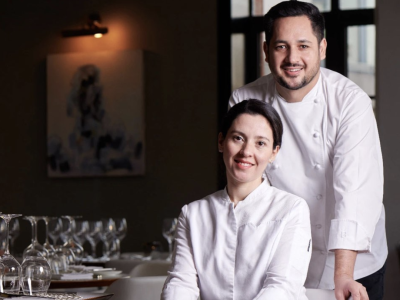In July, I visited “Ginza Kojyu,” a two-Michelin-star kaiseki restaurant in the fiercely competitive culinary district of Ginza, Tokyo. Located on the fourth floor of a building amidst Ginza’s glittering facades, its discreet signage is easy to miss if you’re not looking closely.
When the elevator doors opened, a different world unfolded — a small garden with stone paths led me to the counter seats. Chef Toru Okuda, with his gentle demeanor and calm presence, greeted us from behind a 700-year-old hinoki cypress counter. After a brief exchange of pleasantries, he surprised us by bringing out hamo (pike conger), a prized summer fish, and began skillfully performing the traditional honegiri (bone-cutting) technique right in front of our eyes.
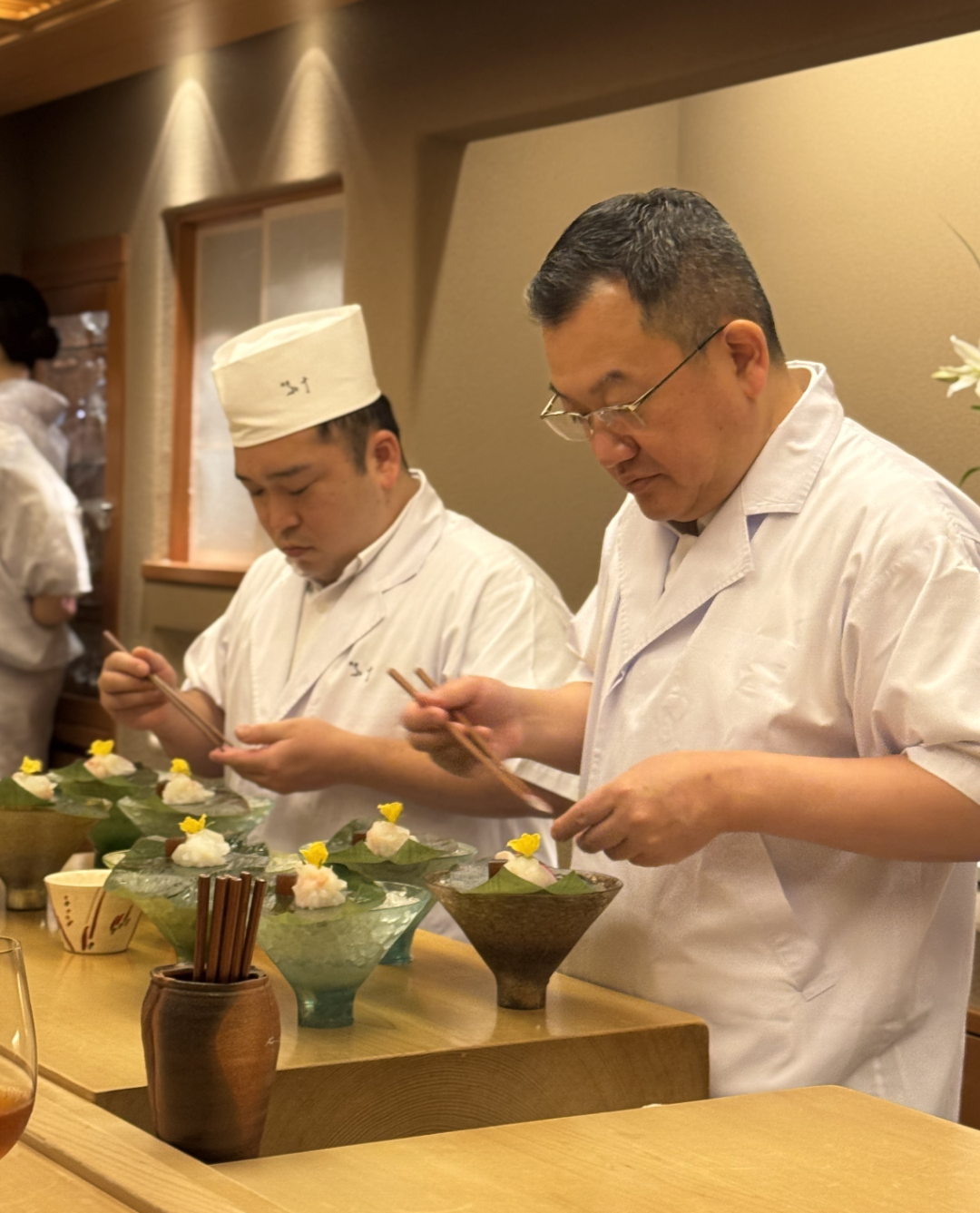 Chef of Ginza Kojyu - Toru Okuta
Chef of Ginza Kojyu - Toru Okuta
In kaiseki, the honegiri technique is one of the truest tests of a chef’s skill, and mastering this alone can take five to ten years. Pike conger is at its fattest and most flavorful before autumn, but its flesh is riddled with tiny bones only about 1–2 centimeters apart. The bones must be cut without piercing the skin — typically at intervals of “one inch, twenty-five cuts” — requiring exact precision. With a calm and practiced motion, Chef Okuda tilted his knife and produced the rhythmic cutting as he worked, more effortlessly than I can slice onions at home.
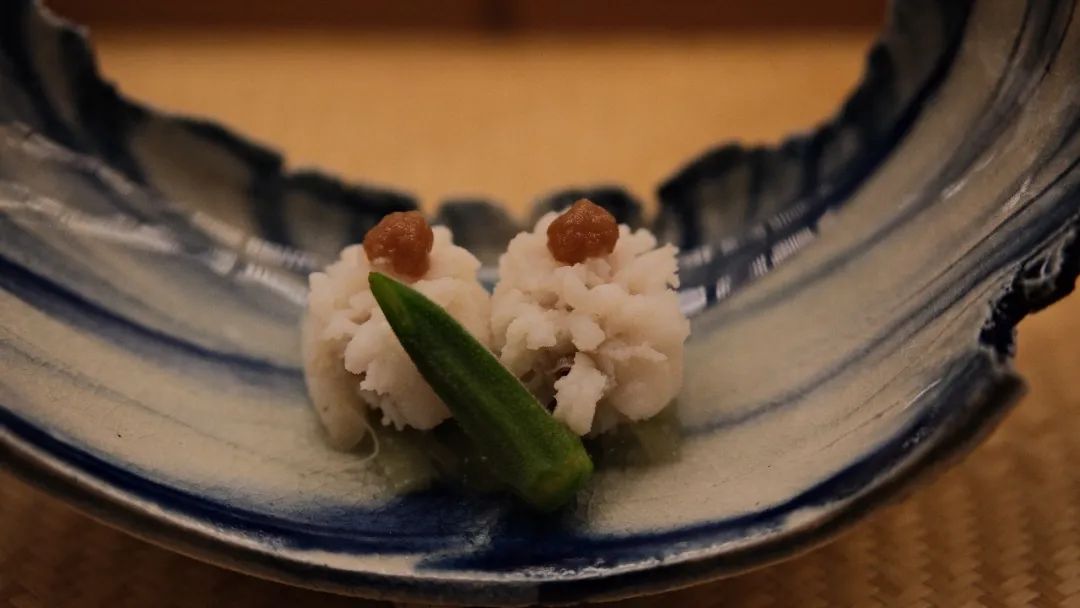 Hamo
Hamo
Once prepared, the hamo got a quick blanch in hot water and an immediate ice bath. The meat curled slightly, tender yet springy, with bones so finely cut they disappeared on the palate. Paired with tart plum sauce and crisp okra, its subtle fragrance shone through.
Next came fatty tuna belly diced into cubes, lightly seared and dressed in a soy-egg yolk sauce, and so tender it melted right away. Sweet, creamy purple sea urchin (Murasaki Uni) and briny nori deepened the ocean’s embrace; The steamed abalone, thick and springy, was paired with Kamo eggplant, tofu purée, and edamame, all finished with a deep green sauce made from abalone liver, heightening the shellfish’s natural intensity. Ise lobster and flounder sashimi followed — the lobster crisp yet yielding, the flounder delicate and sweet — each served with their ideal condiments of ponzu, soy sauce, and wasabi.
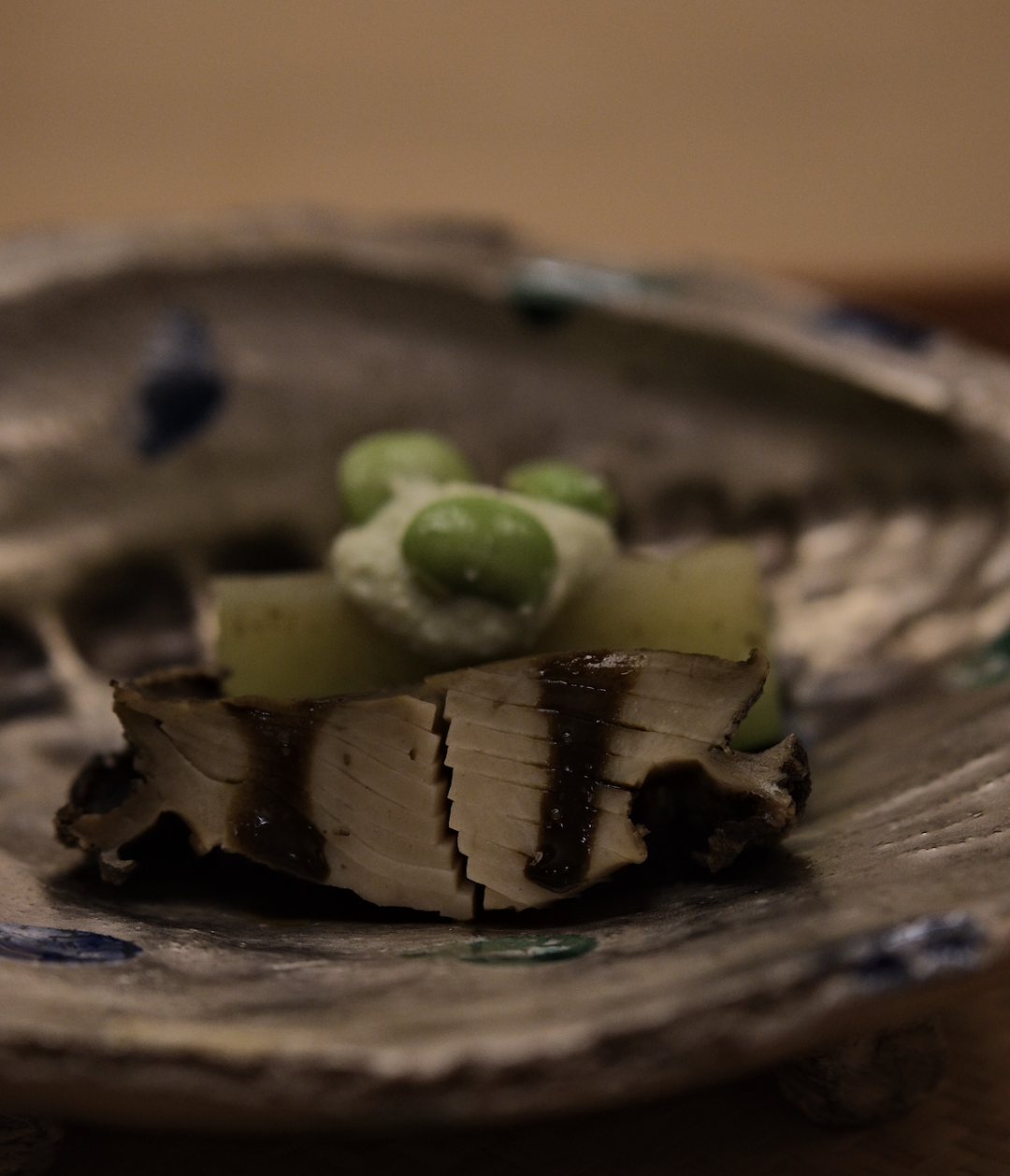 Abalone
Abalone
The wanmono (soup) course was prawn shinjo in a clear kombu-bonito broth. While shrimp shinjo is not rare, Kojyu’s rendition was perhaps the softest and richest I’ve had. Unlike the usual round form, this was rectangular, as airy as a soufflé, breaking apart at the lightest touch. Chef Okuda shared that his recipe uses more egg white and yam, giving it an ethereal texture reminiscent of the fluffy tamago-yaki served at top sushi counters.
When the chef presented two deep-fried ayu (sweetfish), my heart leapt. In summer, the must-have seafoods are hamo, unagi, ayu, and abalone — and among them, ayu is my favorite. Instead of the classic tadezu pairing, one was served with soy milk foam, the other with a thick, jam-like sweet pepper sauce — the first leaning Japanese, the second evoking Japanese-Chinese flavors. Biting into the crisp ayu from head to tail, I savored the pleasantly bitter-sweet innards, then the sweet, tender flesh near the tail, and finally the crunchy fin. Two were gone in moments, and I still longed for more.
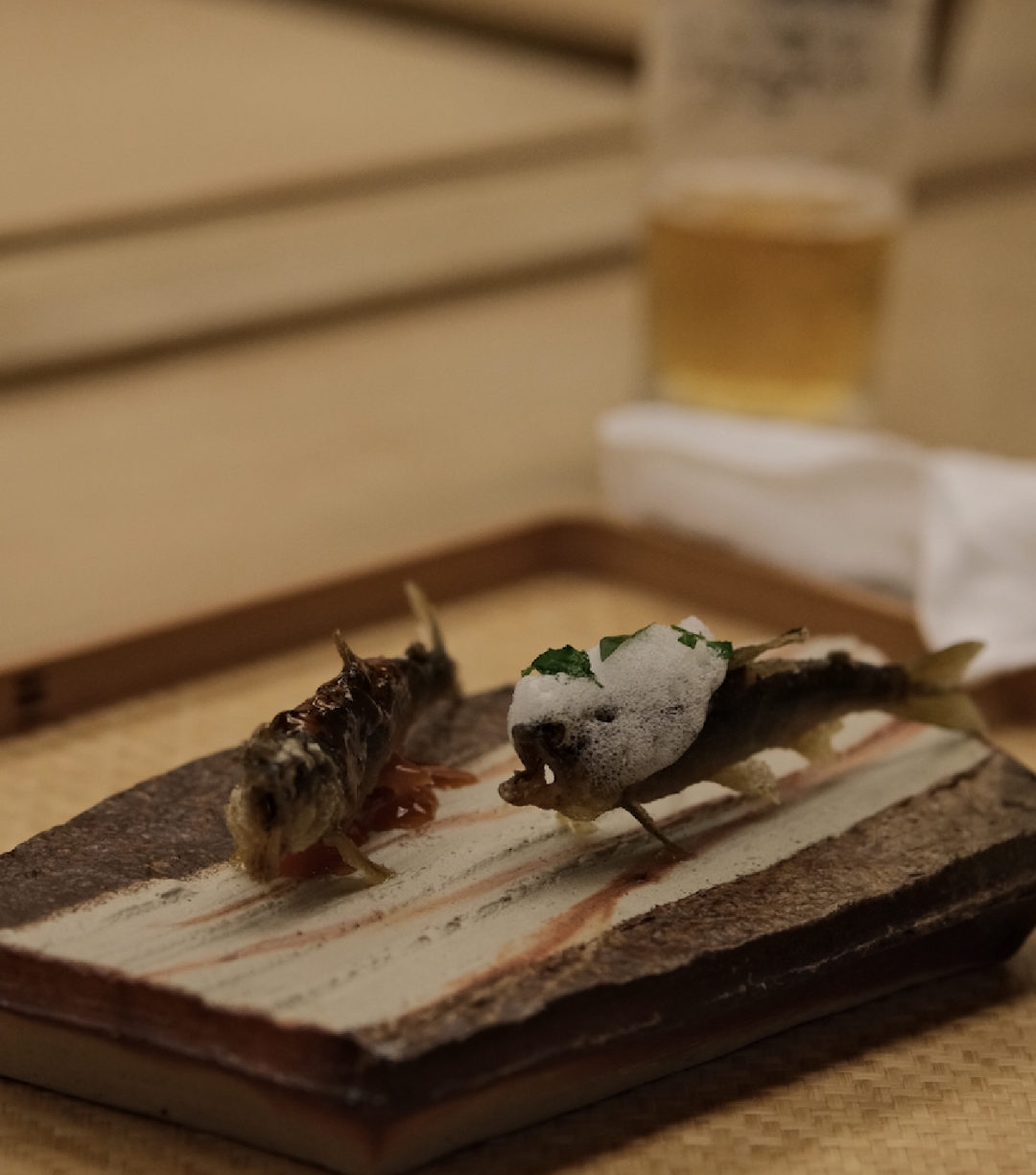 Fried Ayu
Fried Ayu
I recalled that as a child, I preferred plump, roe-laden ayu, avoiding the bitter innards.However, over the years, I’ve grown to appreciate that subtle bitterness and the aroma of its skin and bones. “Japanese people can’t eat spicy like the Chinese, but we love bitterness,” Chef Okuda remarked. No wonder the bitter wild greens of spring, the ayu of summer, and the guts of sanma are so beloved here.
Another fish course followed —kinki (thornhead). Though still midsummer, its flesh was rich with fat, the gelatinous skin tender, the meat fine-grained. It was paired with a tomato broth bright with acidity, alongside seasonal vegetables — new onion, asparagus, zucchini — a harmony of sweet, savory, and tart. “Isn’t this the prominent ‘tomato water’ in western fine dining?” Chef explained that he steams the tomatoes, collecting and reducing the dripping essence. The first sip was distinctly tomato, but with the fish fat layered in, the broth deepened into something hauntingly delicious.
 Kinki, Tomato broth
Kinki, Tomato broth
The meat course was charcoal-grilled wagyu sirloin from Miyazaki’s Ozaki beef. Lightly seared to showcase its marbling, it offered both sweetness of fat and certain milky taste. The sesame-vinegar sauce was toasty, tangy, and bright, balancing the richness. The vividly patterned plate it was served on was as memorable as the flavor — a reflection of the chef’s passion for Karatsu-yaki ceramics, from which even the restaurant’s name “Kojyu” was inspired.
Then came the long-awaited grilled unagi. It was served with tamago-yaki and two petite rice balls — one with shiba pickles, the other with fresh sansho berries. The eel skin was crisp, the flesh thick and tender, brushed with a delicate kabayaki glaze. I especially loved the edges, kissed with char, where smokiness and fat intertwined. While eel is often paired with powdered sansho, I preferred the fresh berries here — citrusy, lightly pickled, with a gentle tingle that was utterly addictive.
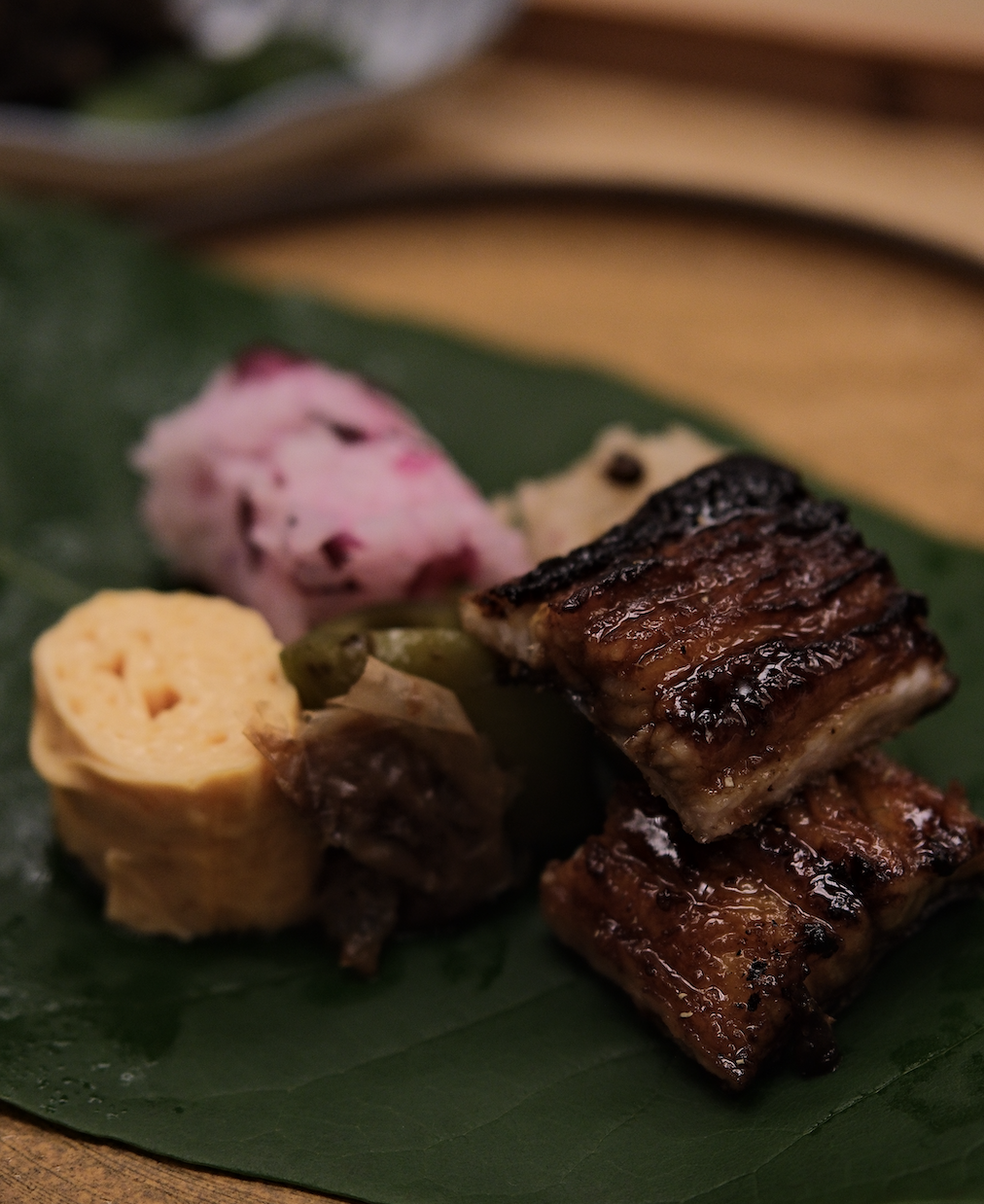 Grilled Eel
Grilled Eel
Dessert was peach granita and mizu-yokan. The granita’s gentle sweetness and floral-fruity aroma, accented with apple and blueberry, refreshed the palate completely. A final sip of hot roasted tea brought the meal to a comforting close.
After the meal, everyone had different personal favorites, but we all agreed that Ginza Kojyu’s broths were exceptional. If French cuisine’s soul lies in its sauces, then in Japanese cuisine, it lies in the broth. Whether in the kombu-bonito broth or the tomato essence for the kinki, Chef Okuda distilled the essence of many ingredients into something clear yet infinitely deep.
Chef Toru Okuda, along with the chefs of three-Michelin-starred “Ryugin” and “Kanda,” all trained at the famed Aoyagi in Tokushima, earning them the nickname “The Three Musketeers of Tokyo Washoku.” “Ginza Kojyu” held three Michelin stars for eight consecutive years since the Tokyo guide’s debut, maintaining two stars since 2015. Chef Okuda has also opened restaurants abroad in New York and Paris (the New York branch has since closed), tirelessly promoting Japanese cuisine worldwide.
Today, using seasonal ingredients are no rarity for restaurants, but Chef Okuda’s cooking shines in its restraint — abundant yet never showy, with bold touches woven subtly into the details. This visit to Ginza Kojyu was not just delicious. It was a quiet yet commanding showcase of the season’s beauty, captured in every dish.
Many wonder if Ginza Kojyu will reclaim its third star, but I wonder if this matters to him that much any more. Besides working in the kitchen, Chef Okuda writes, teaches, and advocates for Japanese cuisine with eyes bright and a heart as pure as a child’s. Clearly, this is way more admirable than a star.
Author:Patty Chuang
Images: Patty Chuang


